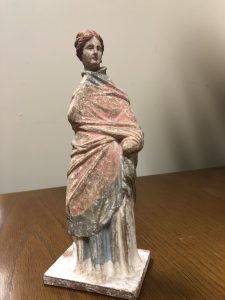
The AMCA Lab is proud to house many artifacts from all over the world and across the eras, and today we would like to highlight one particular artifact, FIG 828, our replica Tanagra Figurine! This figurine was gifted to us by the Newfields Museum, and while it is probably not authentic, it sure is pretty to look at. We know that it’s not authentic because it still has most of its colorful paints on it, and because there is a price tag on the bottom of its stand. While we know that it is not authentic, there’s no way for us to know when it’s actually from because it doesn’t have a date of any kind attached to it. Here’s some information about authentic Tanagra Figurines!
Ancient Tanagra was an early rival of the city of Thebes in the 4th century BCE. Tanagra was also the center of the Boeotian League for a little while, but after losing battles in the first Peloponnesian War Tanagra was sent into a period of decline. Tanagra was only able to briefly revive itself during the height of the Hellenistic period before declining again. Today Tanagra is little more than a train station on the way from Athens to Thebes. Most of the ruins are gone, and all that remains of its ancient glory are the figurines that were pulled out of Tanagra’s massive cemeteries in the 1880’s.
Tanagra Figurines were first discovered in the 1880’s and the world was immediately taken by storm. Demand for the figurines was so high that the market soon became flooded with forgeries and replicas. The original figurines were also mass produced using separate molds for the front and back of the figurine with both parts fused together before the firing took place. The statues were also painted in a white slip clay before firing as a sort of primer for the colorful paints to stick to after firing. One issue that arose with painting the statues white before firing and then colorful after firing is that the colorful paints rubbed off of the statues extremely quickly. As a result, authentic Tanagra Figurines today rarely if ever have any colorful paints left on them. A red color was commonly used for a figurines hair, lips, and shoes while a black color was used for eyes and eyebrows. A peach color was used for the skin and a rose color was used for the clothes that the figurines were often depicted wearing. Blue paints were extremely expensive, so they were used sparingly on Tanagra figurines and the color green was never used at all. Tanagra Figurines also featured a vent hole on the back to ensure that moisture would be able to seep out during the firing process and prevent them from exploding.
When Tanagra Figurines were first discovered, early archaeologists believed them to be related exclusively to burial rites. The figurines themselves almost entirely depicted the daily lives of women, which contrasted the idea that they were only related to death and the afterlife. The idea that all Greek terracottas from that time were funerary objects came from archaeologists associating the location the figurines were found in with the significance they held to the people using them. Tanagra Figurines depicting daily life challenged the idea of all terracottas being related to funerary rites. A big breakthrough in the way that the statues were interpreted came when the German archaeologist Franz Winter decided to start classifying statues by what they were depicting and not by where or when they were from. Creating the new system of classification took Winter almost 10 years to complete, and became the standard way of classifying statuettes that is still used today.
Sources
Department of Greek and Roman Art. “Tanagra Figurines.” Metmuseum.org, www.metmuseum.org/toah/hd/tafg/hd_tafg.htm.
Neer, Richard T. Art & Archaeology of the Greek World: a New History, c. 2500-c. 150 BCE. Thames and Hudson, 2019.
“Tanagra Figurine.” Encyclopædia Britannica, Encyclopædia Britannica, Inc., www.britannica.com/art/Tanagra-figurine.
“Tanagra.” Encyclopædia Britannica, Encyclopædia Britannica, Inc., www.britannica.com/place/Tanagra.
Uhlenbrock, Jaimee P. “The Study of Ancient Greek Terracottas: A Historiography of the Discipline.” Harvard University Art Museums Bulletin, vol. 1, no. 3, 1993, pp. 7–27. JSTOR, www.jstor.org/stable/4301471. Accessed 7 Mar. 2021.
